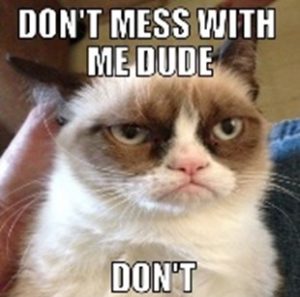Are you typing out a tweet using the "@" mention function? If so, think about what you're doing because the other person you're mentioning might reply with "don't @ me." This post unpacks everything you need to know about the meaning and origin of this expression.
Don't @ Me Meaning
The @ function on Twitter allows you to address someone on the platform directly. If you "mention" someone using the "@" symbol in front of their username, and they replay with "don't @ me," they are telling you to refrain from mentioning them in your tweets.
For instance, you could type out a lyric to your favorite song and mention the artist in your tweet. If they reply with "don't @ me," it means that they don't want to see their lyrics appear in their feed because it's annoying and clogging up their timeline.
The "@" symbol allows you to connect with other people on Twitter, and it's a way for your followers to see the person you're referencing.
If someone sends you "don't @ me," they are telling you to stop mentioning them online. It could be because they don't like what you have to say about them, or because they are a celebrity, and you're fanboying out on them, embarrassing yourself and the user.
While the phrase is common on Twitter, it also appears on other social media platforms like Facebook and Instagram, where you can mention other users with the "@" symbol.
Don't @ Me Example Usage
"I'm tired of you piggybacking off my name, don't @ me, you peasant."
"Don't @ me on Twitter; I have nothing to say to you."
"Stop mentioning me on Twitter to get clout for your posts. Don't @ me, or I'll come after you."
"Don't @ me if you're just quoting lines from my songs; I don't want to see it."
"Why are people mentioning me in posts talking about that event? Don't @ me; I wasn't even there."


Don't @ Me Origin
The origin of the idiomatic expression "don't @ me" comes from social media, namely Twitter. Twitter debuted in 2006 and quickly started growing as people voiced their opinion on topics online using 140-characters or less.
As the platform developed, the Twitter team introduced the "mention" function, using the "@" symbol. By typing @ followed by a username, the post would automatically appear in the user's feed, in a "mention." It became a popular way of targeting a specific tweet at another user or notifying other users or followers of posts you find interesting on the platform.
The first recorded use of the phrase "don't @ me" on Twitter comes from the user, "ChrisPirillo." He issued a tweet saying the following, "don't @ me – e or d me instead – otherwise, i will never see your comments – read my previous twitter – t9ing from pocket ie."
Phrases Similar to Don't @ Me
- Don't mention me.
- Don't talk to me.
- Take my name out of your mouth.
Phrases Opposite to Don't @ Me
- Holla @ me.
- Hit me up.
What is the Correct Saying?
- Don’t @ me.
Ways People May Say Don't @ Me Incorrectly
Some people may use the phrase in spoken conversations, but it doesn't have the same meaning as it does online. Typically, the term tells someone to stop mentioning you online, not in the real world.
Acceptable Ways to Phrase Don't @ Me
You can use the phrase "don't @ me" on social media platforms like Twitter, Facebook, and Instagram. The "@" symbol is a way of mentioning someone in a post, drawing their attention to what you have to say. Therefore, you'll use the phrase when you're telling people not to use your name to gain clout on their profile.